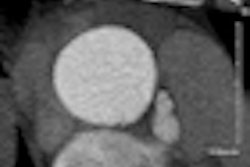Wisconsin researchers have found that using a prospectively triggered CT aortography technique can dramatically cut radiation dose compared to retrospective triggering for the same exam, according to a new study in the October issue of the American Journal of Roentgenology.
The research team, led by Dr. Wenhui Wu and colleagues from the Medical College of Wisconsin in Milwaukee, concluded that prospectively gated studies should be the preferred method of ruling out suspected aortic dissection or following up after cardiac interventional procedures.
Wu and colleagues compared radiation dose, contrast load, thoracic aortic attenuation value, and image quality parameters of MDCT thoracic aortography performed with prospective and retrospective cardiac gating in 80 patients being evaluated for thoracic aortic aneurysm (n = 23), suspected aortic dissection (n = 36), or postintervention follow-up (n = 21) (AJR, October 2009, Vol. 193:4: pp. 955-963).
All patients had normal sinus rhythm at the time of the exam, with a mean heart rate of 63 beats per minute. There were 40 patients in the prospective electrocardiogram (ECG)-gated group (24 men, 16 women; mean age, 60.3 ± 13.78 years) and 40 in the retrospective ECG-gated group (22 men, 18 women; mean age, 55.3 ± 14.42 years). Scans extended from the proximal brachiocephalic arteries to the origin of the celiac artery in the upper abdomen.
The results showed substantially lower radiation doses with the use of prospective ECG triggering, as measured by CT dose index volume and dose-length product.
Radiation dose, prospective gating versus retrospective gating
|
"Even with optimum ECG-dependent tube current modulation, the radiation dose from retrospective ECG-gated acquisition is still higher than that of prospective ECG-gated acquisition," they wrote.
Attenuation was slightly higher with prospective gating, while the contrast dose was slightly lower, the authors wrote. Meanwhile, subjective scores of motion artifact and banding artifact were equivalent between the two groups.
In a disclosure statement, Wu stated that he was at the Medical College of Wisconsin at the time of the study for a visiting fellowship sponsored in part by GE Healthcare of Chalfont St. Giles, U.K., which manufactured the scanner used in the study. Senior author Dr. Dennis Foley has an investigator agreement with GE.
Related Reading
Abdominal fat linked to aortic calcification, September 1, 2009
Multislice CT beats aortography for pediatric thoracic aortic coarctation, December 25, 2009
Good long-term results seen with balloon angioplasty for aortic coarctation, December 3, 2008
UFE without standard aortography cuts radiation dose, May 18, 2007
Cardiovascular risk related to aortic calcification seen on CT colonography, June 29, 2006
Copyright © 2009 AuntMinnie.com



















